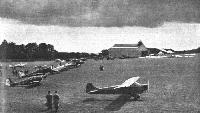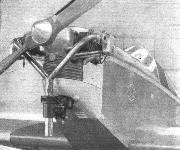
Самолеты семейства "Dart"
<...>
Последним самолетом, выпущенным "Dart Aircraft", стал Dart Kitten - одноместный сверхлегкий низкоплан, оснащенный двигателем Ava 4a-00 мощностью 27 л.с. (20 кВт). Самолет Kitten I совершил первый полет 15 января 1937 года, а в августе был передан заказчику, но уже в сентябре перепродан новому владельцу и в течение Второй мировой войны хранился в Рирсби и вновь поднялся в воздух только в 1949 году в Броксбёрне, где на него был установлен новый двигатель Aeronca-JAP J-99. Самолет разбился в авиакатастрофе 23 ноября 1952 года. Второй самолет, Kitten II, с самого начала был построен с двигателем J-99 и совершил первый полет весной 1937 года. Он также пережил войну, вновь поднявшись в небо в Саутенде, а в 1951 году был построен еще один самолет данного семейства - Kitten III, отличавшийся тем, что имел колесные тормоза.
ТАКТИКО-ТЕХНИЧЕСКИЕ ХАРАКТЕРИСТИКИ
Dart Kitten II/III
Тип: одноместный легкий самолет
Силовая установка: ПД Aeronca-JAP J-99 мощностью 36 л.с. (27 кВт)
Летные характеристики: макс. скорость на уровне моря 153 км/ч; крейсерская скорость на высоте 610 м - 134 км/ч; практический потолок 6005 м; дальность 547 км
Масса: пустого 231 кг; максимальная взлетная 341 кг
Размеры: размах крыла 9,68 м; длина 6,50 м; высота 2,41 м; площадь крыла 11,98 м'
Описание:
- Самолеты семейства "Dart"
- Flight, December 1936
RECRUITS for the LIGHT BRIGADE - Flight, February 1937
ANOTHER RECRUIT
Фотографии
-
Aeroplane Monthly 1986-02 / Dart Kitten II G-AEXT /Preservation Profile/
Регистрационный номер: G-AEXT [16] -
Aeroplane Monthly 1977-08 / A.Ord-Hume - Dart Kitten /British pre-war ultralights/
Регистрационный номер: G-AERP [8] Two views of the completed prototype taken in 1937.
-
Flight 1937-02 / Flight
Регистрационный номер: G-AERP [8] This Flight photograph of the Kitten gives a good idea of its comparatively large size.
-
Aeroplane Monthly 1984-01 / A.Curtis - Dart deeds
Регистрационный номер: G-AERP [8] A.Curtis flying the prototype Dart Kitten at Hatfield on March 20, 1937. The picture was taken by his missus.
-
Aeroplane Monthly 1977-08 / A.Ord-Hume - Dart Kitten /British pre-war ultralights/
Регистрационный номер: G-AERP [8] A. R. Weyl testing the Kitten I, G-AERP, near Dunstable in January 1937. Note the lack of engine cowlings and the long, straight exhaust pipes of the 27 h.p. Ava flat-four two-stroke engine.
In this flying picture, the "gull" effect may just be discerned. -
Flight 1937-03 / Flight
Регистрационный номер: G-AERP [8] Designed to be flown by the novice pilot: the Dart Kitten, at present fitted with a 7 h.p. Ava flat-four two-stroke engine.
-
Aeroplane Monthly 1984-01 / A.Curtis - Dart deeds
Регистрационный номер: G-AERP [8] The prototype Dart Kitten, G-AERP, at Dunstable in January 1937. It is fitted with the original Ava engine.
-
Flight 1937-02 / Flight
Регистрационный номер: G-AERP [8] LIGHTWEIGHT: The Dart Kitten, which is now flying
-
Aeroplane Monthly 1977-08 / A.Ord-Hume - Dart Kitten /British pre-war ultralights/
Регистрационный номер: G-AERP [8], G-AEXT [16] Kittens G-AERP and G-AEXT together at Hatfield in 1937.
-
Aeroplane Monthly 1984-01 / A.Curtis - Dart deeds
Регистрационный номер: G-AEXT [16] Dart Kitten G-AEXT at Hatfield in May 1937 with, it is believed, Weyl in the cockpit. The apparent gull shape of the wing is evident.
-
Aeroplane Monthly 1986-02 / Dart Kitten II G-AEXT /Preservation Profile/
Регистрационный номер: G-AEXT [16] 'XT snapped at Hanworth on May 29,1937 at the start of the Isle of Man air race; F. D. Bradbrooke is in the cockpit.
-
Aeroplane Monthly 1986-01 / Grapevine
Регистрационный номер: G-AEXT [16] Clive Stubbings' newly restored 1937 Dart Kitten, G-AEXT, Made its first air display appearance at Old Warden on October 27, 1985.
-
Aeroplane Monthly 1988-05 / Personal album. Civil
Регистрационный номер: G-AEXT [16] Dart Kitten G-AEXT, photographed at Lympne in 1937. First flown in May 1937, the Kitten Mk II featured a 36 h.p. Aeronca-JAP J-99 engine, remodelled top decking and L-type undercarriage axle.
-
Flight 1937-07 / Flight
Регистрационный номер: G-AEXT [16] The start: P. B. Elwell's Taylor Cub is seen getting away, and Alington's Dart Kitten is next in the line.
Другие самолёты на фотографии: Taylor Cub - США - 1931
-
Air-Britain Archive 1984-02
Регистрационный номер: G-AEXT [16] The Dart Kitten G-AEXT receiving some loving care at Stapleford on 29.6.61, about the time that it was acquired by Ron Long of Navestock. It crashed 29.11.64 at Willingale, was purchased in 1976 by M.W.Rice for restoration which has proceeded through further changes of ownership, and is currently nearing completion at Cambridge. Note the Messenger fuselages including G-ALAW in the back of the hangar!
Другие самолёты на фотографии: Miles Messenger M.38 / M.48 - Великобритания - 1942
-
Aeroplane Monthly 1977-08 / A.Ord-Hume - Dart Kitten /British pre-war ultralights/
Регистрационный номер: G-AEXT [16] F. D. Bradbrooke swinging 'XT's compass at Hatfield three days before the Isle of Man Race.
-
Aeroplane Monthly 1984-01 / A.Curtis - Dart deeds
Регистрационный номер: G-AEXT [16] F. D. Bradbrooke sets off from Hanworth in Kitten II G-AEXT on May 29, 1937, in The Isle of Man Race, only to be forced down with engine trouble.
-
Aeroplane Monthly 1984-01 / A.Curtis - Dart deeds
Регистрационный номер: G-AEXT [16] The second Dart Kitten, G-AEXT, with tail up at Hanworth May 1937 at the start of the Isle of Man race; Bradbrooke of The Aeroplane is the pilot. Note the amount of down elevator. Bradbrooke was forced down at Bicester with oil pump trouble and damaged his hand trying to turn the engine over.
-
Aeroplane Monthly 1977-08 / A.Ord-Hume - Dart Kitten /British pre-war ultralights/
Регистрационный номер: G-AEXT [16] John Fricker air testing Kitten II G-AEXT for The Aeroplane in 1950, when the aircraft was owned by W. G. A. Harrison. This owner had G-AEXT completely rebuilt after the war.
-
Мировая Авиация 100
Регистрационный номер: G-AEXT [16] По состоянию на 2010 год, самолет Dart Kitten II (G-AEXT) все еще числился в британском гражданском авиареестре.
-
Aeroplane Monthly 1986-02 / Dart Kitten II G-AEXT /Preservation Profile/
Регистрационный номер: G-AEXT [16] John Fricker peers over his shoulder while positioning G-AEXT for The Aeroplane’s photographer in 1950.
-
Aeroplane Monthly 1987-01 / G.Cains - Fast and furious (1)
Регистрационный номер: G-AEXT [16] Dawson-Paul lands Dart Kitten G-AEXT at Mousehold aerodrome, Norwich in 1938.
-
Aeroplane Monthly 1977-08 / A.Ord-Hume - Dart Kitten /British pre-war ultralights/
Регистрационный номер: G-AMJP Kitten III G-AMJP, fitted with wheel brakes, crashed at Hillington, King's Lynn, on June 5, 1966. A fourth Kitten, VH-WGL, was home-built at Port Moresby in New Guinea. Does anyone have any photos of this aircraft, please?
-
Flight 1937-05 / Flight
The new engine has been very neatly installed in the Kitten as this Flight photograph of its nose shows
-
Aeroplane Monthly 1987-01 / G.Cains - Fast and furious (1)
Регистрационный номер: G-AEXT [16] Dart Kitten G-AEXT following a forced landing at Broxbourne in 1939, sitting atop Frank Dawson-Paul's car.
-
Flight 1936-12 / Flight
The Dart Kitten (25 h.p. Ava)
- Фотографии

























